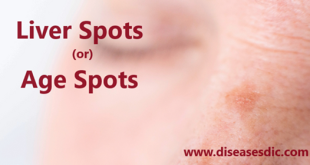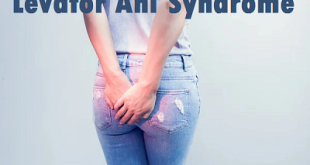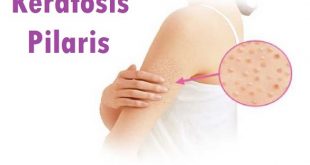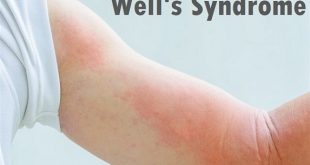What is lichen sclerosus?
Lichen sclerosus (LS) is a long-term (chronic) skin condition. It causes the skin to become thin, white, and wrinkly. It may occur in men, women, and children at any age. But it is most common in women older than age 50.
Skin has several layers. The outer layer is the epidermis. Under this is the dermis. The dermis contains blood vessels, nerve endings, hair roots, and sweat glands. With lichen sclerosus, the epidermis may become thin. Inflammatory cells invade the dermis. This may cause swelling and broken blood vessels. Stretchy fibers in the skin (elastic and collagen) may break. All of this can lead to symptoms such as itching, pain, and blisters.
This condition often affects the genital and anal areas. Vulvar lichen sclerosus is a common form of the condition that affects a woman’s external genital areas. Less often, lichen sclerosus can affect other parts of the body. These may include the neck, shoulder, breast, thighs, or mouth.
Pathophysiology
Inflammation and altered fibroblast function in the papillary dermis lead to fibrosis of the upper dermis. Genital skin and mucosa are affected most frequently, with only rare reports of oral presentations. It has been hypothesized that oral manifestations are underdiagnosed or misdiagnosed as oral lichen planus, or that environmental effects play a large role in disease expression.
Findings within LS tissue include the following:
- Increased glut-1 and decreased vascular endothelial growth factor (VEGF) expression – Suggesting a role for hypoxia and ischemia)
- Higher expression of extracellular matrix (ECM) proteins and connective-tissue growth factor (CTGF) – Up-regulation may induce accumulation of ECM proteins and maintain fibrosis in chronic vulval lichen sclerosus
- Altered expression of isocitrate dehydrogenase enzymes and aberrant hydroxymethylation – Indicating an epigenetic background for the pathogenesis of vulval lichen sclerosus)
- Increased levels of TH1-specific cytokines, a dense T-cell infiltrate and enhanced BIC/miR-155 expression, and a microRNA involved in regulation of the immune response – Demonstrating an autoimmune phenotype in vulvar lichen sclerosus
- Distinct expression patterns of tissue remodelling–associated genes in boys with congenital phimosis and lichen sclerosus
- Decreased or absent epidermal expression of CD44 – Suggesting lichen sclerosus might result from epidermal damage of unknown origin, resulting in CD44-deficient dermal changes with hyaluronic acid accumulation
- Increased incidence of autoantibodies to EMC protein 1 and to BP180 antigen, with increased circulation of NC16A domain–specific T cells
What causes lichen sclerosus?
The cause of lichen sclerosus is not fully understood and may include genetic, hormonal, irritant, traumatic and infectious components.
Lichen sclerosus is often classified as an autoimmune disease. Autoimmune diseases are associated with antibodies to a specific protein.
- Extracellular matrix protein-1 (ECM-1) antibodies have been detected in 60–80% of women with vulval lichen sclerosus.
- Antibodies to other unknown proteins may account for other cases, explaining differing presentations of lichen sclerosus and response to treatment.
- However, these antibodies could be epigenetic, ie, the results of disease rather than the cause of disease.
Male genital lichen sclerosus is rare in men circumcised in infancy. It has been suggested that it may be caused by chronic, intermittent damage by urine occluded under the foreskin.
As onset in women is commonly postmenopausal, a relative lack of oestrogen may be significant.
Who is at risk for lichen sclerosus?
You may have a greater risk if you have an autoimmune disease such as:
- Autoimmune-related thyroid disease
- Autoimmune-related anemia
- Vitiligo
- Type 1 diabetes
- Alopecia areata
Other factors that can increase your risk include:
- A history of sexual abuse
- A history of the condition in your family
Circumcision greatly lowers the risk of lichen sclerosus in men.
Symptoms
People with mild lichen sclerosus may have no signs or symptoms.
Signs and symptoms usually affect the skin of the genital and anal areas, but may also affect the skin of the upper body, upper arms and breasts. They may include:
- Redness
- Itching (pruritus), which can be severe
- Discomfort or pain
- Smooth white patches on your skin
- Blotchy, wrinkled patches
- Tearing or bleeding
- In severe cases, bleeding, blistering or ulcerated sores
- Painful sex
Complications
- Lichen sclerosus can cause the skin to crack and bleed. When the area around the genitals is affected, it can be particularly painful and sore.
- In severe cases of lichen sclerosus, scarring can cause the walls of the vagina to shrink and tighten, making sexual intercourse very difficult and painful.
- Lichen sclerosus does not cause cancer. However, women whose genitals are affected are at a higher risk of developing some forms of skin cancer. This cancer risk accounts for less than 5 percent of women with the condition, however. Developing cancer is more likely to happen to a woman if she has not managed her symptoms through treatment.
Lifestyle impacts due to lichen sclerosus
Diagnosis of Lichen Sclerosus
The presenting symptoms of LS may have an overlap with other dermatological conditions. Therefore, some tests will need to be performed to eliminate differential diagnoses. Diagnostic methods include:
- Considering family history: A personal history of LS will greatly increase suspicion of the disease.
- Physical examination: The lesions, scarring (if present) and/or bruises will be examined. A full body exam may be conducted to check for dermatological issues elsewhere as well. The spread and type of lesions will help to narrow the cause of the disease.
- Biopsy: Samples from the affected areas may be taken. This is primarily done to eliminate other suspicions and to check for infections since they can arise independently as well. Similarly, blood work may be carried out to check for hormonal imbalances as well.
What is the treatment for lichen sclerosus?
Patients with lichen sclerosus are best to consult a doctor with a particular interest in the condition for accurate diagnosis and treatment recommendations.
They are advised to become familiar with the location and appearance of their lichen sclerosus.
- Women may use a mirror when applying topical therapy.
- Photographs may help in monitoring activity and treatment.
General measures for genital lichen sclerosus
- Wash gently once or twice daily.
- Use a non-soap cleanser, if any.
- Try to avoid tight clothing, rubbing and scratching.
- Activities such as riding a bicycle or horse may aggravate symptoms.
- If incontinent, seek medical advice and treatment.
- Apply emollients to relieve dryness and itching, and as a barrier to protect sensitive skin in genital and anal areas from contact with urine and faeces.
Topical steroid ointment
Topical steroids are the primary treatment for lichen sclerosus. An ultrapotent topical steroid is often prescribed (eg, clobetasol propionate 0.05%). A potent topical steroid (eg, mometasone furoate 0.1% ointment) may also be used in mild disease or when symptoms are controlled.
- An ointment base is less likely than cream to sting or to cause contact dermatitis.
- A thin smear should be precisely applied to the white plaques and rubbed in gently.
- Most patients will be told to apply the steroid ointment once a day. After one to three months (depending on the severity of the disease), the ointment can be used less often.
- Topical steroid may need to be continued once or twice a week to control symptoms or to prevent lichen sclerosus recurring.
- Itch often settles within a few days, but it may take weeks to months for the skin to return to normal (if at all).
- One 30-g tube of topical steroid should last 3 to 6 months or longer.
The doctor should reassess the treated area after a few weeks, as a response to treatment is quite variable.
Topical steroids are safe when used appropriately. However, excessive use or application to the wrong site can result in adverse effects. In anogenital areas, these include:
- Red, thin skin
- Burning discomfort
- Periorificial dermatitis
- Candida albicans infection (eg, vulvovaginal thrush)
It is most important to follow instructions carefully and to attend follow-up appointments regularly.
Other topical therapy
Other topical treatments used in patients with lichen sclerosus include:
- Intravaginal oestrogen cream or pessaries in postmenopausal women. These reduce symptoms due to atrophic vulvovaginitis (dry, thin, fissured and sensitive vulval and vaginal tissues due to hormonal deficiency).
- Topical calcineurin inhibitors tacrolimus ointment and pimecrolimus cream instead of or in addition to topical steroids. They tend to cause burning discomfort (at least for the first few days). Early concern that these medications may have the potential to accelerate cancer growth in the presence of oncogenic human papillomavirus (the cause of genital warts) appears unfounded.
- Topical retinoid (eg, tretinoin cream) is not well tolerated on genital skin but may be applied to other sites affected by lichen sclerosus. It reduces scaling and dryness.
Oral medications
When lichen sclerosus is severe, acute, and not responding to topical therapy, systemic treatment may rarely be prescribed. Options include:
- Intralesional or systemic corticosteroids
- Oral retinoids: acitretin, isotretinoin
- Methotrexate
- Ciclosporin
Surgery
Surgery is essential for high-grade squamous intraepithelial lesions or cancer.
In males, circumcision is effective in lichen sclerosus affecting prepuce and glans of the penis. It is best done early if initial topical steroids have not controlled symptoms and signs. If the urethra is stenosed or scarred, reconstructive surgery may be necessary.
In females, the release of vulval and vaginal adhesions and scarring from vulval lichen sclerosus may occasionally be performed to reduce urination difficulties and allow intercourse if dilators have not proved effective. Procedures include:
- Simple perineotomy (a division of adhesions)
- Fenton procedure (an incision that is repaired transversely)
- Perineoplasty (excision of involved tissue and vaginal mucosal advancement)
Unfortunately, LS sometimes closes up the vaginal opening again after surgery has initially appeared successful. It can be repeated.
Other treatments
Other reported treatments for lichen sclerosus are considered experimental at this time.
- CO2 laser ablation of hyperkeratotic plaques
- Er:YAG laser
- Phototherapy
- Photodynamic therapy
- Fat injections
- Stem cell and platelet-rich plasma injections Lifestyle and home remedies
Lifestyle and home remedies
These self-care tips may help, whether you are undergoing treatment or not:
- Apply lubricant (petroleum jelly, A and D ointment, Aquaphor) to the affected area.
- Gently wash the affected area daily and pat dry. Avoid harsh soaps and bathing too much.
- Ease burning and pain with oatmeal solutions, sitz baths, ice packs or cool compresses.
- Take an oral antihistamine at bedtime to help control the itching as you try to sleep.
Can I prevent lichen sclerosus?
There is no way to prevent lichen sclerosus. You may be able to relieve symptoms with lifestyle changes.
To reduce friction and irritation, you should:
- Avoid horseback riding and long bike rides.
- Wear loose-fitting underwear and clothing.
- Use unscented soaps and laundry detergent. Avoid bubble baths — the suds can cause irritation that makes itching worse.
- Change out of wet swimsuits and clothing right away.
There isn’t a recommended lichen sclerosus diet. But some studies show that dietary changes can relieve symptoms of LS. Talk to your provider about foods you should avoid and how to make healthy choices.
 Diseases Treatments Dictionary This is complete solution to read all diseases treatments Which covers Prevention, Causes, Symptoms, Medical Terms, Drugs, Prescription, Natural Remedies with cures and Treatments. Most of the common diseases were listed in names, split with categories.
Diseases Treatments Dictionary This is complete solution to read all diseases treatments Which covers Prevention, Causes, Symptoms, Medical Terms, Drugs, Prescription, Natural Remedies with cures and Treatments. Most of the common diseases were listed in names, split with categories.







